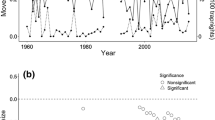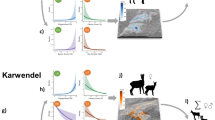Summary
Social behavior is one hypothesized cause for dispersal. We tested this hypothesis on spruce grouse (Dendragapus canadensis) in two years by removing adults in summer and monitoring emigration of juveniles in autumn. Despite the absence of adults, juveniles emigrated from the natal range at rates comparable to juveniles on control areas. Data on density and dispersal from earlier spruce grouse studies are reviewed, which show that emigration is constant despite substantial differences in density, and that a clear female sex bias occurs across a wide range of densities. Results do not support the hypothesis that social behavior influences dispersal nor do they support a prediction of the “Oedipus hypothesis” that no sex bias occurs in polygynous birds.
Similar content being viewed by others
References
Aldrich JW (1963) Geographic orientation of American Tetraonidae. J Wildl Manage 27:529–545
Bekoff M (1977) Mammalian dispersal and the ontogeny of individual behavioral phenotypes. Am Nat 111:715–732
Brody AK, Armitage KB (1985) The effect of adult removal on dispersal of yearling yellow-bellied marmots. Can J Zool 63:2560–2564
Christian JJ (1970) Social subordination, population density, and mammalian evolution. Science 168:84–90
Dobson FS (1979) An experimental study of dispersal in the California ground squirrel. Ecology 60:1103–1109
Dobson FS (1985) The use of phylogeny in behavior and ecology. Evolution 39:1384–1388
Dunn PO, Braun CE (1985) Natal dispersal and lek fidelity of sage grouse. Auk 102:621–627
Fairbairn DJ (1978) Behaviour of dispersing deer mice (Peromyscus maniculatus). Behav Ecol Sociobiol 3:265–282
Festa-Bianchet M, King WJ (1984) Behavior and dispersal of yearling Columbian ground squirrels. Can J Zool 62:161–167
Gaines MS, McClenaghan LR Jr (1980) Dispersal in small mammals. Annu Rev Ecol Syst 11:163–196
Gates JM, Hale JB (1974) Seasonal movement, winter habitat use, and population distribution of an east central Wisconsin pheasant population. Tech Bull 76, Dept Nat Resourc, Madison WI
Gauthreaux SA Jr (1978) The ecological significance of behavioral dominance. In: Bateson PPG, Klopfer PH (eds) Perspectives in ethology. Plenum Press, New York, pp 17–54
Greenwood PJ (1980) Mating systems, philopatry and dispersal in birds and mammals. Anim Behav 28:1140–1162
Gregory MJ, Cameron GN (1988) Examination of socially induced dispersal in Sigmodon hispidus. J Mammal 69:251–260
Herzog PW, Boag DA (1978) Dispersion and mobility in a local population of spruce grouse. J Wildl Manage 42:853–865
Hoffman RW, Braun CE (1975) Migration of a wintering population of white-tailed ptarmigan in Colorado. J Wildl Manage 39:485–490
Howard WE (1960) Innate and environmental dispersal of individual vertebrates. Am Midl Nat 63:152–161
Jamieson IG, Zwickel FC (1983) Dispersal and site fidelity in blue grouse. Can J Zool 61:570–573
Jenkins D, Watson A, Miller GR (1967) Population fluctuations in the red grouse Lagopus lagopus scoticus. J Anim Ecol 36:97–122
Keppie DM (1977) Inter-brood movements of juvenile spruce grouse. Wilson Bull 89:67–72
Keppie DM (1979) Dispersal, overwinter mortality, and recruitment of spruce grouse. J Wildl Manage 43:717–727
Keppie DM (1987) Impact of demographic parameters upon a population of spruce grouse in New Brunswick. J Wildl Manage 51:771–777
Keppie DM (1991) The termination of spring display by male spruce grouse, and commencement of egg-laying by females. Can J Zool 69:3000–3004
Liberg O, Schantz T von (1985) Sex-biased philopatry and dispersal in birds and mammals: the Oedipus hypothesis. Am Nat 126:129–135
Liberg O, Schantz T von (1988) The Oedipus hypothesis: a reply to Marks and Redmond. Am Nat 132:155–158
Lidicker WZ Jr (1962) Emigration as a possible mechanism permitting the regulation of population density below carrying capacity. Am Nat 96:29–33
Lumsden HG (1961) Displays of the spruce grouse. Can Field-Nat 75:152–160
Martin K, Hannon SJ (1987) Natal philopatry and recruitment of willow ptarmigan in north central and northwestern Canada. Oecologia 71:518–524
Moore J, Ali R (1984) Are dispersal and inbreeding avoidance related? Anim Behav 32:94–112
Morris DW (1982) Age-specific dispersal strategies in iteroparous species: who leaves when? Evol Theory 6:53–65
Murray BG Jr (1967) Dispersal in vertebrates. Ecology 48:975–978
Nugent DP, Boag DA (1982) Communication among territorial female spruce grouse. Can J Zool 60:2624–2632
Oring LW (1982) Avian mating systems. In: Farner DS, King JR (eds) Avian Biology, vol VI. Academic Press, New York, pp 1–92
Robel RJ, Henderson FR, Jackson W (1972) Some sharp-tailed grouse population statistics from South Dakota. J Wildl Manage 36:87–98
Schroeder MA (1986) The fall phase of dispersal in juvenile spruce grouse. Can J Zool 64:16–20
Small RJ, Rusch DH (1989) The natal dispersal of ruffed grouse. Auk 106:72–79
Szuba KJ, Bendell JF (1988) Non-territorial males in populations of spruce grouse. Condor 90:492–496
Towers J (1988) Age determination of juvenile spruce grouse in eastern Canada. J Wildl Manage 52:113–115
Waser PM (1985) Does competition drive dispersal? Ecology 66:1170–1175
Wiley RH (1974) Evolution of social organization and live-history patterns among grouse. Q Rev Biol 49:201–227
Zwickel FC, Bendell JF (1967) A snare for capturing blue grouse. J Wildl Manage 31:202–204
Author information
Authors and Affiliations
Additional information
Offprint requests to: D.M. Keppie
Rights and permissions
About this article
Cite this article
Keppie, D.M., Towers, J. A test on social behavior as a cause of dispersal of spruce grouse. Behav Ecol Sociobiol 30, 343–346 (1992). https://doi.org/10.1007/BF00170601
Received:
Accepted:
Issue Date:
DOI: https://doi.org/10.1007/BF00170601




